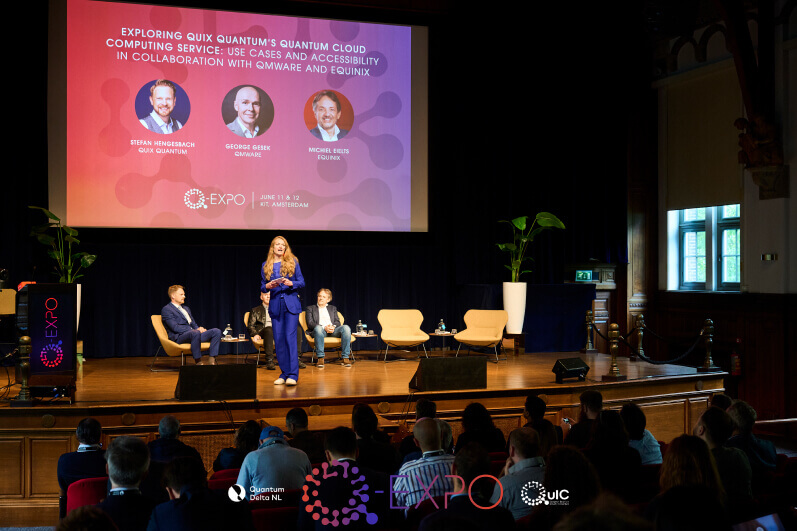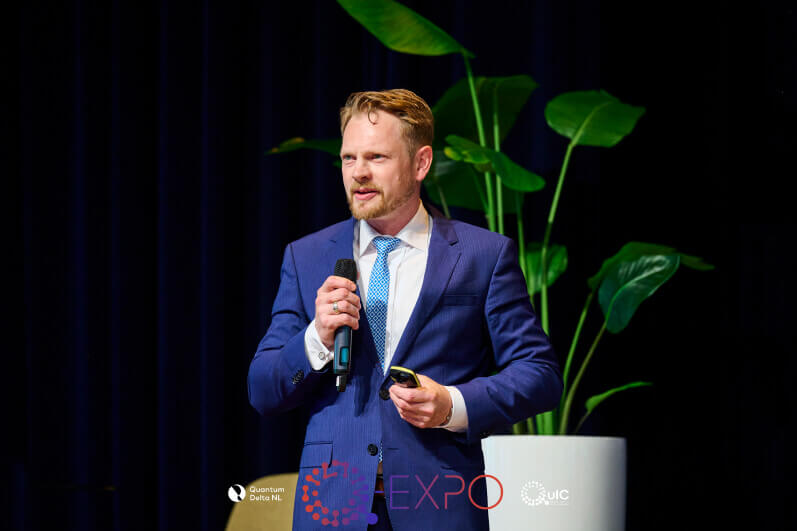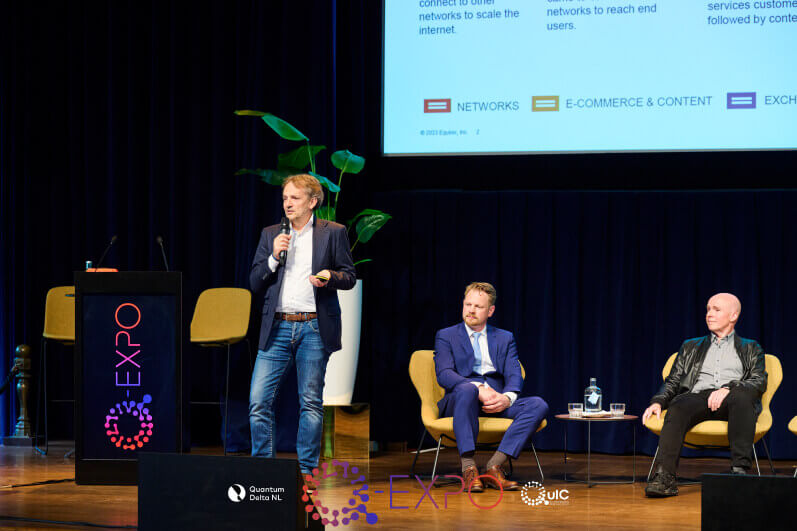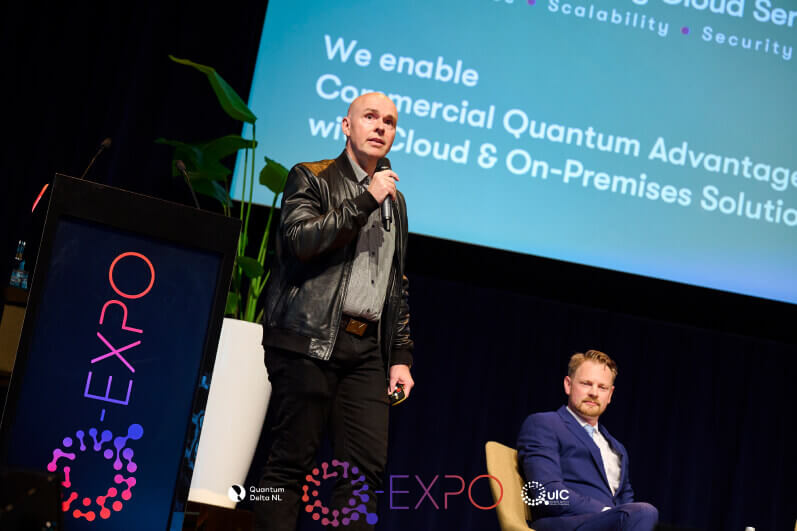QuiX Quantum Cloud Access: Another milestone for the partnership with QMware
A conversation with Dr. Stefan Hengesbach (CEO QuiX Quantum) and George Gesek (CTO and co-founder QMware)

Alongside QuiX Quantum and Equinix, QMware took the stage at the Q-Expo during the Quantum Meets conference in Amsterdam on June 12th. QuiX Quantum revealed the launch of their proprietary quantum cloud access for September 17th. This launch marks a significant milestone in the partnership between the two companies, enabling QMware to integrate the QuiX Quantum QPU into its hybrid quantum cloud. In a moderated conversation, Dr. Stefan Hengesbach (CEO QuiX Quantum) and George Gesek (CTO and co-founder QMware) share more background about the launch and their partnership.

Stefan, you had some good news today. Announcing the launch of your quantum computing cloud access. What can users expect on September 17th?
Stefan Hengesbach: Users can expect two types of access to our Bia™ quantum computer. The first is for scientific users, offering remote access that is straightforward and without additional services. The second type of access is through QMware, which combines the HPC with the quantum computer and includes a range of additional services. This option is tailored to industrial customers.

You were on stage today with QMware and Equinix. Can you share more insights on how you collaborate with both partners to bring your hardware capabilities to the market?
Stefan Hengesbach: Firstly, I must emphasize that we are building a hybrid quantum computer that integrates an HPC (High-Performance Computer) with a QPU (Quantum Processing Unit), specifically our quantum computer Bia™. Equinix hosts the HPC component of this hybrid quantum computer in their data center in Enschede. There are two ways to connect our Bia quantum computer to the HPC: either by connecting the Bia system located at our headquarters in Enschede via a direct glass fiber to the Equinix data center, which is conveniently situated across the street, or by placing our hardware directly in the Equinix data center. This requires designing our hardware to be data center compatible, which is a crucial aspect for us.
In summary, QMware is an expert in hybrid quantum computing and will offer the computing power and services to their customers, Equinix is the market leader in data center operations and will host the infrastructure, and QuiX Quantum as a full hardware-stack quantum computing company, will provide the quantum computer connected to the HPC.

When you say it’s important for us to design the hardware so it’s compatible for data centers, what is the challenge there?
Stefan Hengesbach: The hardware is housed in a 19-inch rack and utilizes standard telecom fibers and connectors. A data center compatible product design ensures high uptime, low power consumption, low thermal load, easy maintenance, electromagnetic compatibility, and straightforward installation. These features ensure that our Bia™ rack can be easily rolled into a data center and connected, making it essentially plug-and-play.
Last year, QuiX Quantum and QMware announced their partnership. George, can you elaborate on how QMware is integrating QuiX Quantum into its hybrid platform to be accessed by a broad base of users?
George Gesek: Until now different approaches have been developed to integrate QPUs into HPCs via web or QCU interfaces. [Red. QCU = Quantum Control Unit] But QPU integration into modern cloud data centers consists of much more than a mere data link. We tackle this with our Quantum Hypervisor qognite™ which in turn hides the complexity of the quantum computing operations from the application which uses both, classical and quantum computing resources. To make it work, we design intermediate representations and instruction sets that are downward compatible with future advancements in QPU technology. In this vein, QMware provides investment security for our industry clients even with the usage of highly sophisticated QPUs and their rapid development, like the one by QuiX.

At the Q-Expo, the discussion focused on the commercialization and the benefits of quantum computing technology today. With the QMware – QuiX Quantum partnership, what are your expectations in terms of market access?
Stefan Hengesbach: Let me begin by emphasizing that Equinix, QMware, and QuiX Quantum are committed to the long-term vision of achieving a 250,000 physical qubit quantum computer. We are in a marathon and are dedicated to this long-term goal. However, in the near future, photonic quantum computing is particularly well-suited to addressing special-purpose applications. These include quantum machine learning, random number generation, Monte Carlo analysis, and quantum random walks. Our current chips are specifically designed for these applications, allowing us to effectively map neural networks onto the interferometers we are developing. My commercial expectation is that we leverage these capabilities available to us today.
Ideally, people will use these machines as a sandbox to experiment with smaller problem sets. For instance, if you can optimize the scheduling of two or three trains, it opens the possibility of understanding the potential behind these applications and how much computing power they require from quantum computers.
George Gesek: As Jensen Huang always says, Nvidia has prepared for the thousand-billion market by developing a zero-billion market for a long time. Today quantum computing is in this small but already existing global market of hundreds of millions which expands exponentially. I believe quantum computing will come into today’s stage of AI in about 5 years. Then it will probably be already a ten billion market. But don’t ask me if this is Euro or Dollar.
Let’s give us an outlook on the road ahead. What’s coming for QuiX Quantum, QMware and Equinix?
George Gesek: Without the cloud, there is no AI. And the same is true for quantum computing. We are integrating into the Hyperscalers data centers and building step by step the commercial quantum advantage for our customers. The commercial usefulness of quantum computing can only be achieved by full integration into the global IT value chain.
Stefan Hengesbach: It may be worthwhile to address the current challenges faced by photonic quantum computing. Specifically, what prevents us from delivering a quantum computer with 250,000 qubits today? The answer lies in the availability of photon sources.
While we have made significant strides in developing the detectors, processors, and their firmware, the critical missing component is the source of indistinguishable photons. This issue is resolvable, but it remains a gap in the ecosystem primarily because, prior to the quantum computing era, there was no demand for single indistinguishable photons. Now, with the advent of quantum computing, there is a substantial demand.
The technology is entirely feasible and achievable. It requires engineering time, wafer runs, and further development of control electronics. We initiated this process a year and a half ago, and it is being actively addressed.
Scaling in photonics is relatively straightforward since we have the only qubit information carriers that move at the speed of light and can be interconnected with standard telecom fibers. This creates a direct link to data centers, eliminating the need for conversion to microwaves or frequency conversion to telecom standards. If we can demonstrate a universal error-corrected measurement-based quantum computer on a small scale, scaling up with photonics will not be the hard part.
The initial challenge lies in creating the first hundred physical qubits. However, once we demonstrate this capability, scaling up will involve interconnecting numerous modules with fibers, and from there, the process will rapidly accelerate.
Thank you very much for the conversation!